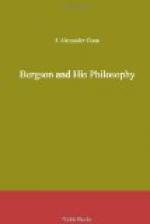CHAPTER V
THE RELATION OF SOUL AND BODY
The hypothesis of Psycho-physical Parallelism—Not to be accepted uncritically—Bergson opposes it, and shows the hypothesis to rest on a confusion of terms. Bergson against Epiphenomenalism—Soul-life unique and wider than the brain—Telepathy, subconscious action and psychical research—Souls and survival.
For philosophy in general, and for psychology in particular, the problem of the relation of soul and body has prime significance, and moreover, it is a problem with which each of us is acquainted intimately and practically, even if we know little or nothing of the academic discussions, or of the technical terms representing various views. It is very frequently the terminology which turns the plain man away from the consideration of philosophical problems; but he has some conception, however crude it may be, of his soul or his mind and of his body. These terms are familiar to him, but the sight of a phrase like “psycho-physical parallelism” rather daunts him. Really, it stands for quite a simple thing, and is just the official label used to designate the theory commonly held by scientific men of all kinds, to describe the relation of soul and body. Put more precisely, it is just the assertion that brain and consciousness work on parallel lines.
Bergson does not accept the hypothesis of psycho-physical parallelism. In the first of his four lectures on La Nature de l’Ame, given at London University in 1911, we find him criticizing the notion that consciousness has no independence of its own, that it merely expresses certain states of the brain, that the content of a fact of consciousness is to be found wholly in the corresponding cerebral state. It is true that we should not find many physiologists or philosophers who would tell us now that “the brain secretes thought as the liver secretes bile."[Footnote: Cabanis (1757-1808). Rapports du physique et du morale de l’homme, 1802. See quotation by William James in Human Immortality. Note (4) in his Appendix.] But there was an idea that, if we could see through the skull and observe what takes place in the brain, if we had an enormously powerful microscope which would permit us to follow the movements of the molecules, atoms, electrons, of the brain, and if we had the key to the correspondence between these phenomena and the mind, we should know all the thoughts and wishes of the person to whom the brain belonged—we should see what took place in his soul, as a telegraph operator could read by the oscillation of his needles the meaning of a message which was sent through his instrument. The notion of an equality or parallelism between conscious activity and cerebral activity, was commonly adopted by modern physiology, and it was adopted without discussion as a scientific notion by the majority of philosophers. Yet the experimental basis of this theory is extremely slight, indeed altogether




